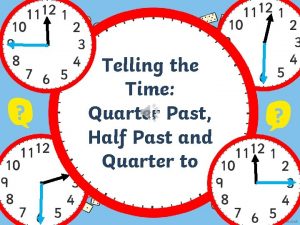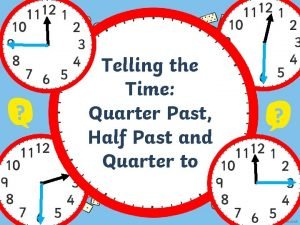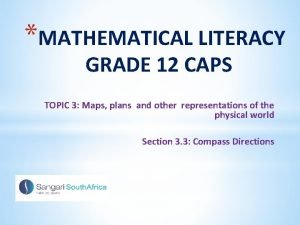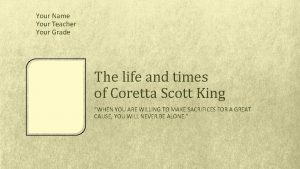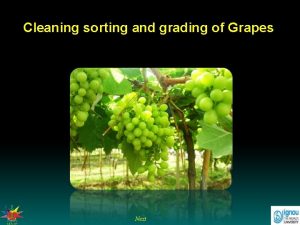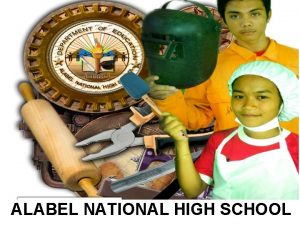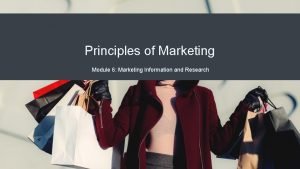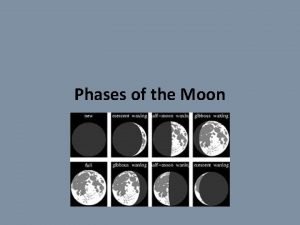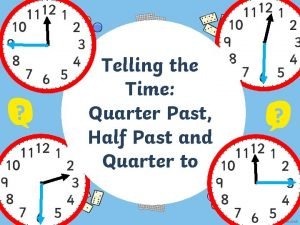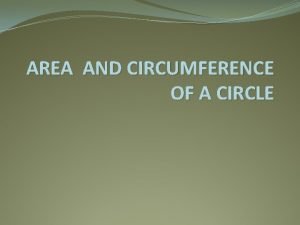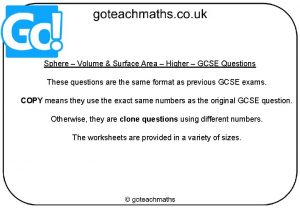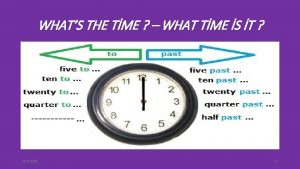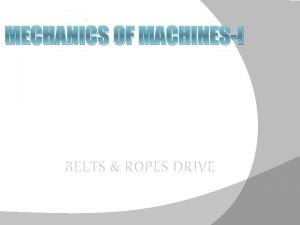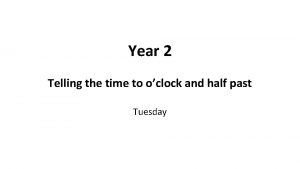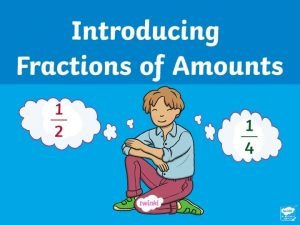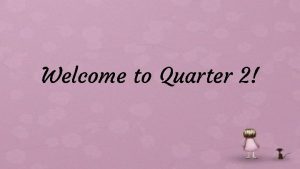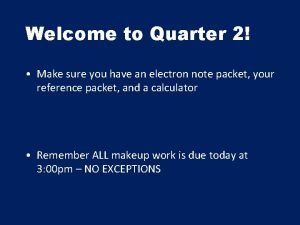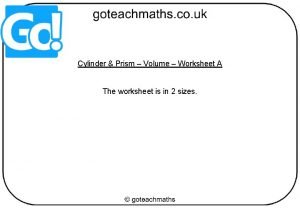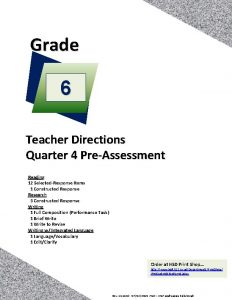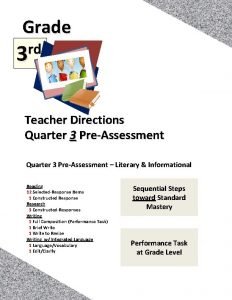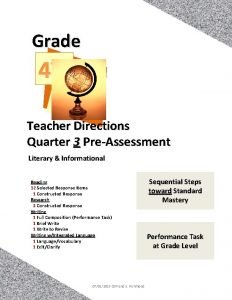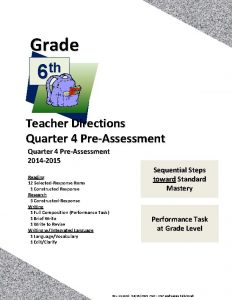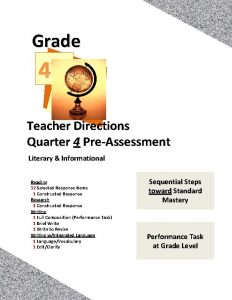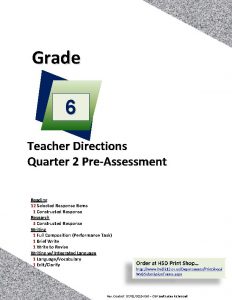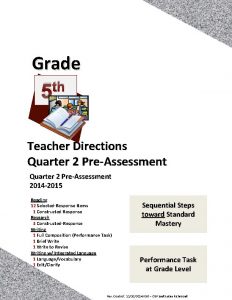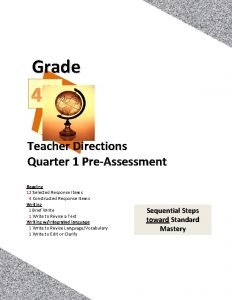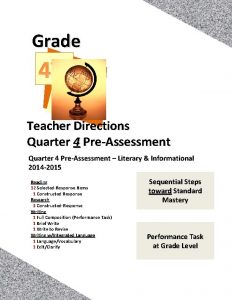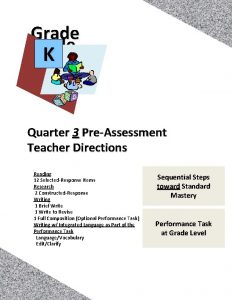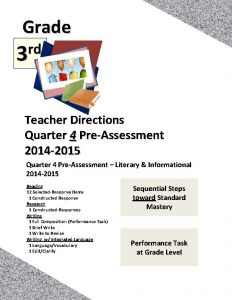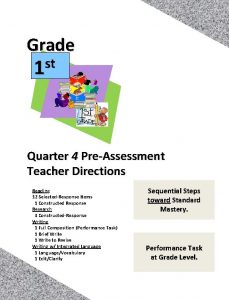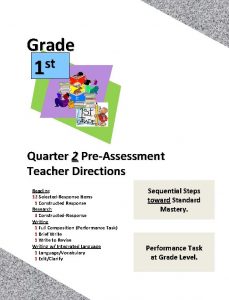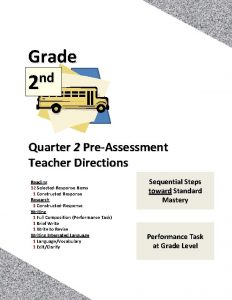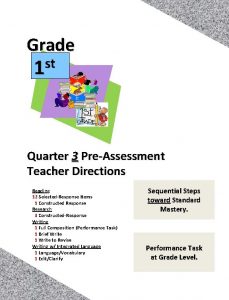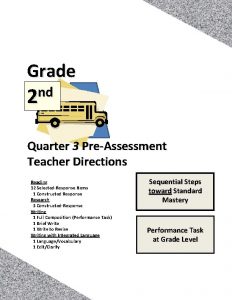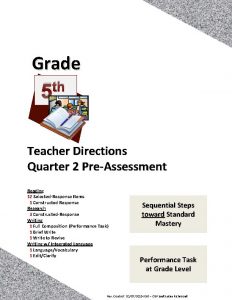Grade rd 3 Teacher Directions Quarter 1 PreAssessment





























- Slides: 29

Grade rd 3 Teacher Directions Quarter 1 Pre-Assessment 2014 -2015 12 Selected-Response Items 4 Constructed-Response Items 1 Brief Write 1 Write to Revise a Text 1 Write to Revise Language/Vocabulary 1 Write to Edit or Clarify

rd 3 Quarter One 2014 -15 Pre-Assessment Reading: Literature Targets Standards 1 Key Details RL. 1 2 Central Ideas RL. 2 RL. 3 (can move to a DOK of 3) DOK 1 -2 2 Reading: Informational Targets Standards 8 Key Details RI. 1 9 Central Ideas RI. 2 RI. 3 (can move to a DOK of 3) DOK 1 -2 2 Writing Targets Standards DOK 6 a Brief Opinion Write W-1 a, W-1 b, W-1 c, W-1 d, W-8 3 6 b Write-Revise Opinion W-1 a, W-1 b, W-1 c, W-1 d, W-8 2 8 Language-Vocabulary Use L-3 a 1 -2 9 Edit and Clarify L. 3. 1 i 1 -2

Order at HSD Print Shop… http: //www. hsd. k 12. or. us/Departments/Print. Shop/ Web. Submission. Forms. aspx Directions The HSD Elementary assessments are neither scripted nor timed assessments. They are a tool to inform instructional decision making. All students should “move toward” taking the assessments independently but many will need scaffolding strategies. It is not the intent of these assessments to have students “guess and check” answers for the sake of finishing an assessment. If that seems the case, please scaffold to gain a true understanding of student ability, noting when and what accommodations were needed. Connecting Assessment to Classroom Instruction How do the assessments connect to classroom instruction? Assessment is not an isolated event. The HSD assessments are an extension of classroom instruction. In the classroom assessment is on-going and monitors progress toward standards mastery. Assessment Components as a Routine Classroom Practices Assessment Components Pre-Assessments Standard DOK Level Instructional Components Use the DOK Leveled Learning Progression Tasks to monitor standard mastery. 50% Literary and 50% Informational Text Students have equal access to both text types. Grade Level Content-Rich Text All students read grade-level text, content rich text (with scaffolds as needed). Standard Academic Vocabulary Content-Domain Vocabulary. Ask questions using the standard’s vocabulary as well as the content domain vocabulary. Text –Dependent Questions Ask text-dependent questions from the standard’s DOK level. Selected and Constructed Responses Students have many opportunities to answer selected extended or constructed responses. Reading for Meaning Assess understanding using never before seen text (although theme or topic should be grade-level “friendly” or familiar) and reading rubrics. Note-Taking Students “take notes” as they read to identify the central or main idea and its supporting details. SBAC Reading/Writing Rubrics Use SBAC rubrics to access reading/writing. Read to Write Evidenced-Based Model Students read, discuss and write about a topic using evidence from the text to support inferences, conclusions and generalizations. Write and Revise Students revise brief texts, correct grammar and language/vocabulary in context and write brief texts (brief write rubrics should be used). Performance Tasks Students read, write, discuss and research a topic guided by a central insight or goal throughout a unit(s) of study with fully defined criteria, culminating in a final product or “performance task. ” The final product can be a full composition, speech (using SBAC Rubrics) or other product meeting all criteria. Rev. Control: 08/25/2014 HSD – OSP and Susan Richmond

Pre-Assessment and Learning Progressions The pre-assessments are unique. They measure progress toward a standard Unlike the Common Formative Assessments which measure standard mastery, the pre-assessments are more like a base-line picture of a student’s strengths and gaps, measuring skills and concepts students need “along the way, ” in order to achieve standard mastery. END of Beg. of QTR CFA Example of a Learning Progression for RL. 2. 1 Pre-Assessments Measure Adjustment Points (in purple) RL. 2. 1 grade -level standard assessment. After the pre-assessment is given, Learning Progressions provide informal formative assessment below and near grade-level “tasks” throughout each. Throughout quarter. DOK 1 - Ka Recall who, what, where, when, why and how about a story read and discussed in class. DOK - Kc Use and define Standard Academic Language: who, what, where, when, why, and how; ask, answer, questions, key details DOK 1 - Cd Connect the terms who to characters; where and when to setting; what and how to sequence of events. DOK 1 - Cf Ask and answer who, what, where, when, why and how questions about key details in a text. the QTR DOK 2 - Ch Concept Development Student understands that key details help tell who, what, where, when, why and how. DOK 2 - Ck Uses key details to identify who, what, where, when, why and how about a story not read in class. QTR DOK 2 -Cl Finds information using key details to answer specific questions about a new story. Standard Mastery RL. 2. 1 Ask and answer such questions as who, what, where, when, why, and how to demonstrate understanding of key details in a text So what about a “post-assessment? ” There is not a standardized post-assessment. The true measure of how students are doing “along the way, ” is assessed in the classroom during instruction and classroom formative assessment. For this reason The CFA’s are not called “post-assessments. ” The CFAs measure the “end goal, ” or standard mastery. However, without the pre-assessments, how will we know what our instruction should focus on throughout each quarter? Learning Progressions: are the predicted set of skills needed to be able to complete the required task demand of each standard. The learning progressions were aligned to Hess’ Cognitive Rigor Matrix. The pre-assessments measure student proficiency indicated on the boxes in purple (adjustment points). These points are tasks that allow us to adjust instruction based on performance. For instance, if a student has difficulty on the first “purple” adjustment point (DOK-1, Cf) the teacher will need to go back to the tasks prior to DOK-1 Cf and scaffold instruction to close the gap, continually moving forward to the end of the learning progression. There is a Reading Learning Progression checklist for each standard in each grade that can be used to monitor progress. It is available at: http: //sresource. homestead. com/Grade-2. html Rev. Control: 08/25/2014 HSD – OSP and Susan Richmond 4

Quarter One Reading Literature Learning Progressions. The indicated boxes highlighted before the standard, are assessed on this preassessment. The standard itself is assessed on the Common Formative Assessment (CFA) at the end of each quarter. DOK 1 - Ka Locate and recalls basic facts or events found explicitly in a story (read and discussed in class). DOK 1 - Ka Recall events and key details from a fable, folktale or myth from diverse cultures (read and discussed in class). DOK 1 - Ka Recall basic questions about characters and events in a story (read and discussed in class). DOK 1 - Kc Define - Understand the meaning standard academic language: text, questions, answers and asks, refer, explicitly, basis DOK 1 - Kc Define standard academic language - myth, fable, folktales, culture, moral, central message, key details, and lesson and convey. DOK 1 - Kc Define standard academic language character, character traits (characteristics, motivation, feelings, etc), events and sequence of time and “contributes to. . . ” DOK 1 - Cf Asks questions about characters, setting, events or conflicts in a text. Answers who, what, when and where questions found explicitly in a text about characters, setting, events or conflicts. SELECTED RESPONSE DOK 1 - Cf Answers who, what, when, where and how questions requiring a description of key details in a fable, folktale or myth. SELECTED RESPONSE DOK 1 - Cd Explain the meaning of character traits and give examples. DOK 1 - Cf Answer who, what, when, where and how questions about characters, traits, Explain the motivations meaning of a and feelings in sequence of a story read events and discussed give an in class. example. NOT ASSESSED DOK 2 - Ch Concept Development Asks or answers questions about story elements (demonstrating an understanding that the text provides information needed to answer questions). DOK 2 - Ch Concept Development Understands that a text has clues (details) indicating the central message. DOK 2 - Ch Concept Development DOK 2 - Ci Uses text evidence to summarize key details of a text. SELECTED RESPONSE DOK 2 - Cj Make logical predictions about how a Explain how character’s characters’ trait may traits may influence an influence their action in a actions with text, supported examples with textual from a text. details. SELECTED RESPONSE DOK 2 - Cl Answers questions about a new story (read but not discussed in class) by referring explicitly to the text as the basis for answers. SELECTED RESPONSE DOK 2 - Ck Identify the central message, lesson or moral of a folktale, myth or fables (read but not discussed in class). DOK 2 - ANq Identify use of literary devices used to describe character traits (i. e. , characterizatio n, word usage, vivid descriptions). Standard RL. 3. 1 Ask and answer questions to demonstrate understanding of a text, referring explicitly to the text as the basis for the answers. DOK 2 - Cl Locate key details that support a central message, lesson or moral for a purpose (author’s message, purpose or theme), (read but not discussed in class). CONSTRUCTED RESPONSE DOK 3 - Cu Explain how a character’s actions contribute to a specific sequence of events using supporting evidence from the text (not discussed in class). SELECTED RESPONSE Standard RL 3. 2 Recount stories, including fables, folktales, and myths from diverse cultures; determine the central message, lesson, or moral and explain how it is conveyed through key details in the text. DOK 3 - APx Outline a progression of character traits in a new text (one not read as a class or discussed). CONSTRUCTED RESPONSE Rev. Control: 08/25/2014 HSD – OSP and Susan Richmond Standard RL 3. 3 Describe characters in a story (e. g. , their traits, motivations, or feelings) and explain how their actions contribute to the sequence of events 5

Quarter One Reading Informational Learning Progressions. The indicated boxes highlighted before the standard, are assessed on this preassessment. The standard itself is assessed on the Common Formative Assessment (CFA) at the end of each quarter. Path to DOK - 1 DOK 1 - K 1 a Locate basic facts or events in a story. DOK 1 - K 1 c Define the terms (understands) text, questions, answers and asks. Path to DOK - 2 DOK 1 - C 1 f Explain who, what, where, when or how when asking or answering questions about the text. NOT ASSESSED DOK 2 - Ch Show relationships between why questions and answers. SELECTED RESPONSE Path to DOK - 1 DOK 1 - Ka Recall key details and from the text. DOK 1 - Kc Define main idea, support, and key details. DOK 1 - Ka Locate or recall specific steps in a technical procedure, historical event or scientific idea or concept. DOK 1 - Kc Define transitional words pertaining to time sequence and cause and effect such as; first, then, next, after that, finally. Define (understand) the terms historical, scientific and technical as well as time, sequence and cause/effect. Standard RI. 31 Ask and answer questions to demonstrate understanding of a text, referring explicitly to the text as the basis for the answers. Path to DOK - 2 DOK 1 - Cf Describe parts of the text that have key details. SELECTED RESPONSE Path to DOK - 1 DOK 2 - Cl Locate information to support answers found in text. SELECTED RESPONSE DOK 2 - Ch Explain how key details indicate a main idea (in general). DOK 2 - Ci Summarize the text by recounting the key details. DOK 2 - Ck Determine the main idea of the text by evidence of key details. SELECTED RESPONSE DOK 2 - Cl Locate the specific key details that support the main idea. CONSTRUCTED RESPONSE Standard RI 3. 2 Determine the main idea of a text; recount the key details and explain how they support the main idea. Path to DOK - 2 DOK 1 - Cf DOK 2 Ch Describe how a series of Explain a cause and effect of a historical events or ideas are related event. by explaining who, what, when, where or how. Explain the sequence of steps in a technical SELECTED RESPONSE procedure. Explain time elements between a series of historical events. Standard RI 3. 3 Describe the relationship between a series of historical events, scientific ideas or concepts, or steps in technical procedures in a text, using language that pertains to time, sequence, and cause/effect Explain the influence of time and cause/effect on scientific ideas or concepts. Rev. Control: 08/25/2014 HSD – OSP and Susan Richmond 6

A Note about constructed responses: Constructed response answers are not written “in stone. ” There is no perfect way a student should respond. Look for the general intent of the prompt and student response and follow the rubric below as much as possible. Use your best judgment. Unlike DOK-1 questions where there is one right and wrong answer, constructed responses are more difficult to assess. Overall consistency of intent based on most of your student responses can guide you. Quarter 1 Pre-Assessment Constructed Response Answer Key Standard RI. 2: 2 Point Short Reading Constructed Response Rubric Question #7 (prompt): Why did the fly not feel special? Use details from the story to support your answer. Directions for Scoring: Write an overview of what students could include in a proficient response with examples from the text. Be very specific and “lengthy. ” Teacher Language and Scoring Notes: Sufficient Evidence may include (1) The fly did not feel special, it was just like all the other flies, (2) The moth and mouse didn’t even notice the fly and (3) The fly didn’t have anything special that he could do like the other animals. Specific identifications from the text could include (1) The fly wasn’t big and couldn’t buzz like the bee and (2) the fly wasn’t colorful and it didn’t have big wings like the butterfly Full Support from the text include other relevant details or examples from the text that support the reasons such as (1) the moth and mouse did notice the fly at night because the fly was small and it was too dark (2) the fly wanted to shine like the stars. 2 1 0 The student gives a proficient response by providing evidence that the fly did not feel special and uses specific examples from the text as well as details about (supports) each example. The fly did not feel special because it was just like all the other flies. It wasn’t big and couldn’t buzz like the bee. It didn’t have large, colorful wings like the butterfly and it didn’t shine like the stars. The student gives a partial response by providing some evidence that the fly did not feel special but few details to support the response. The fly didn't feel special because it was just like all the other flies. It really wanted to feel special. The student provides no evidence that the fly did not feel special and no relevant information or examples from the text. The fly was sad because it did not feel special. Toward RL 3. 2 DOK 2 - Cl Locate key details that support a central message, lesson or moral for a purpose (author’s message, purpose or theme), (read but not discussed in class). 7 Rev. Control: 08/25/2014 HSD – OSP and Susan Richmond

A Note about constructed responses: Constructed response answers are not written “in stone. ” There is no perfect way a student should respond. Look for the general intent of the prompt and student response and follow the rubric below as much as possible. Use your best judgment. Unlike DOK-1 questions where there is one right and wrong answer, constructed responses are more difficult to assess. Overall consistency of intent based on most of your student responses can guide you. Quarter 1 Pre-Assessment Constructed Response Answer Key Standard RL. 3. 3 3 Point Reading Constructed Response Rubric Question #8 (prompt): Why do you think the moon helped the fly shine? Use details from the story to support your answer. Directions for Scoring: Write an overview of what students could include in a proficient response with examples from the text. Be very specific and “lengthy. ” Teacher Language and Scoring Notes: Sufficient Evidence should include examples or details explicitly from the text that answer the question “Why do you think the moon helped the fly shine? ” Specific identifications (supporting details) student responses should in some way state that the moon needed a friend. Full Support (other details) to support that the moon needed a friend could include (1) the moon overheard the fly say he wanted to be special, (2) the moon said he would help the fly if the fly would be his friend, (3) the moon told the fly the secret of shining at night and (4) the fly saying he would always be the moon’s friend since the moon helped him feel special or shine at night. The student gives a proficient response by stating that the moon helped the fly because it needed a friend and used examples or details explicitly from the text to support the response. 3 2 1 0 The moon heard the fly say it wanted to be special. The moon told the fly it would help the fly if it would stay out all night and be the moon’s friend. The fly agreed. Then the moon told the fly how to shine all night. It helped the fly feel special. From then on the fly stayed up all night and the moon was not lonely. They helped each other. The student gives a partial response by stating that the moon helped the fly because it needed a friend and some examples or details explicitly from the text to support the response. The moon was sad because he was lonely. Then he had an idea. He would help the fly and not be lonely anymore. The student gives a minimal response by stating why the moon helped the fly and vague examples or details from the text. I think the moon helped the fly because it felt sorry for the fly. The fly didn’t feel special. The student provides no evidence about why the moon helped the fly and no relevant details or examples. Flies can shine at night if they are fireflies. I caught some in a jar once. Toward RL. 3. 3 DOK 3 - APx Outline a progression of character traits in a new text (one not read as a class or discussed) 8 Rev. Control: 08/25/2014 HSD – OSP and Susan Richmond

A Note about constructed responses: Constructed response answers are not written “in stone. ” There is no perfect way a student should respond. Look for the general intent of the prompt and student response and follow the rubric below as much as possible. Use your best judgment. Unlike DOK-1 questions where there is one right and wrong answer, constructed responses are more difficult to assess. Overall consistency of intent based on most of your student responses can guide you. Quarter 1 Pre-Assessment Constructed Response Answer Key Standard RI. 3. 2: 2 Point Short Reading Constructed Response Rubric Question #14 (prompt): Why is the title Things Wings Do a good title for this passage? Support your answer with details from the text. Directions for Scoring: Write an overview of what students could include in a proficient response with examples from the text. Be very specific and “lengthy. ” Teacher Language and Scoring Notes: Sufficient Evidence to answer the prompt should include details and examples explicitly from the text that explain why The Things Wings Do is a good title for this passage because that is the main idea of the passage. Students should include how the title connects to particular details about different purposes for wings Specific identifications (supporting details) could include text-based information about the different things wings do, including (1) flying, (2) provide hard coverings for protection, (3) bright colors as a warning sign and (4) hiding beneath the wings. Full Support (other details) that could be used as example of what wings do may include (1) one pair of wings is used for flying, and speed, (2) specifics about how fast some insects fly, (3) different kinds of wings on different insects, (4) how a beetle uses its wings and (5) insects that use their wings as camouflage. The student gives a proficient response by providing evidence as to why The things Wings Do is a good title for the passage with details supporting specific examples. 2 1 0 The Things Wings Do is a good title for this passage because it is all about what wings can do. This passage has many examples of how insects use their wings. Wings aren’t just for flying. One example in the passage that shows wings aren’t just for flying is the example of a beetle’s front wings. The front wings are used to protect the beetle from being eaten by birds because they are very hard like a shield. Another use for wings besides flying are the colors and patterns on wings. They can camouflage an insect like grasshoppers and moths. These are just a few examples of why I think the title is a good title. The student gives a partial response by providing some evidence as to why The things Wings Do is a good title for the passage with few details supporting specific examples. I think this is a good title because the story has lots of information about insects and their wings and how they use their wings in different ways. Some insects use them for flying and also for protection. The student gives no response with evidence as to why The things Wings Do is a good title for the passage. Insects have lots of legs and can fly. You can put them in a jar. Some of them have wings. Toward 3. 2 DOK 2 - Cl Locate the specific key details that support the main idea. 9 Rev. Control: 08/25/2014 HSD – OSP and Susan Richmond

A Note about constructed responses: Constructed response answers are not written “in stone. ” There is no perfect way a student should respond. Look for the general intent of the prompt and student response and follow the rubric below as much as possible. Use your best judgment. Unlike DOK-1 questions where there is one right and wrong answer, constructed responses are more difficult to assess. Overall consistency of intent based on most of your student responses can guide you. Quarter 1 Pre-Assessment Constructed Response Answer Key Standard RI. 3. 3 3 Point Reading Constructed Response Rubric Question #16 (prompt): According to the passage Things Wings Can Do, why might some insects act differently than other insects? Directions for Scoring: Write an overview of what students could include in a proficient response with examples from the text. Be very specific and “lengthy. ” Teacher Language and Scoring Notes: Sufficient Evidence of the prompt would include student responses that indicate that students are connecting information within the passage as to why some insects act differently. DOK-2 questions require that students summarize details to reach a conclusion. Student responses should connect the main idea of the passage – wings – to why insects might act differently. Specific identifications (supporting details) could include differences seen in insects that have different (1) shapes and colors, (2) wing coverings – some are hard, (3) wings that camouflage insects and (4) wings that send a warning to birds. Full Support (other details) or examples of how insects act differently could include (1) insects with small wings can fly faster but insects with larger wings go more slowly (2) beetles have front wings with hard coverings to protect the beetle from being eaten so it holds its front wings out to the side and flies with its small back wings and (3) some insects hold very still to blend in with their surroundings, while others don’t hold still because they have bright colored wings to warn off birds. The student gives a proficient response by stating that an insect’s wings determines how it acts and uses examples and details explicitly from the text to support the response. 3 2 1 0 Insects have different kinds of wings that make them act different from each other. An insect with small wings can fly faster than an insect with larger wings. Bees fly fast and butterflies fly slowly. Wings protect insects too. Insects with colorful wings don’t hide because their wings warn birds they are not good to eat, but insects with wings the same color as where they live have to sit very still so birds don’t see them and eat them. The student gives a partial response by stating that an insect’s wings determines how it acts and uses some or partial examples and details from the text to support the response. I think some insects act different than others because their wings are different. Bees have tiny wings and butterflies have larger wings, so they fly different from each other. The student gives a minimal response by stating vague examples or details from the text. Wings are different so insects are different. Wings are pretty and colorful and so are many insects. The student provides no evidence about the prompt and no relevant details or examples. Insects have wings. So do airplanes. Toward 3. 3 DOK 2 Ch Explain the influence of time and cause/effect on scientific ideas or concepts. 10 Rev. Control: 08/25/2014 HSD – OSP and Susan Richmond

Note: “Brief Writes” should take no longer than 10 minutes. Brief writes are scored with a 3 point rubric. Longer writes and/or full compositions are scored with a 4 point rubric. The difference between this rubric and the constructed response reading rubrics, is that the Brief Write Rubric is assessing writing proficiency, while the reading rubrics are assessing comprehension. Brief Write Rubric Writing Standard W. 1 a Opinion Writing Target 6 a Introduce a topic or text clearly, state an opinion, and create an organizational structure in which related ideas are grouped to support the writer’s purpose. Question Prompt #18: Write a paragraph stating your opinion about how the moon and fly helped each other. Use specific details from the text to support your answer. Scoring Notes: Gives essential elements of a complete interpretation of the prompt: Student answers the prompt by stating an opinion about how the moon and fly helped each other and then supporting that opinion with details from the text. Addresses many aspects of the task and provides sufficient relevant evidence to support development: Student addresses the aspects of the task specifically and provides evidence that is relevant to the stated opinion. Student may/may not agree with how the moon and fly helped each other. Either answer is allowable IF there are sufficient details to support their opinion statement. Is focused and organized, consistently addressing the purpose, audience, and task: Student is consistent with addressing the prompt and does not bring in extraneous information that is not based on textual evidence. Includes sentences of varied length and structure: Student uses sentences that convey meaning adequately. 3 2 1 0 Student states a definite opinion about how the moon and fly helped each other and uses specific and sufficient details from the text to support the opinion statement. In my opinion, it was good that the moon and fly helped each other because they both got what they needed. The moon got a friend and wasn’t lonely anymore because the moon told the fly the secret of lighting up at night like the stars. The fly got to feel special because he could light up at night. The fly told the moon it would always shine its light to welcome the moon. They both benefitted. Student states a definite opinion about how the moon and fly helped each other and uses some details from the text to support the opinion statement. I think the moon should help the fly and the fly should help the moon. They both could help each other. The fly now feels very special. Student states a definite opinion about how the moon and fly helped each other but does not use details to support the opinion statement. My opinion is it was good they helped each other. Now they are happy. Student does not state a definite opinion about how the moon and fly helped each other. The moon comes out at night and shines. Rev. Control: 08/25/2014 HSD – OSP and Susan Richmond 11

Grade 3 - Quarter 1 Pre-Assessment Selected Response Answer Key Question 1 Where did the fly get the idea that it wanted to shine? RL. 3. 1 DOK-1 Cf A Question 2 Which statement below was not said by the moon to the fly? RL. 3. 1 DOK-2 Cl D Question 3 Why didn’t the mouse’s mother want it to shine? RL. 3. 2 DOK-1 Cf B Question 4 What sentence best summarizes the last paragraph in the story? RL. 3. 2 DOK-2 Ci A Question 5 What do you predict will happen at night with fly and moon? RL. 3. 3 DOK-2 Cj C Question 6 Why did the moth and mouse not see the fly until it learned how to shine? RL. 3. 3 DOK-3 Cu B Question 7 Literary Constructed Response 3. 2 Question 8 Literary Constructed Response 3. 3 Question 9 What determines how fast an insect flies? RI. 3. 1 DOK-2 Ch C Question 10 How do hard coverings protect a beetle? RI. 3. 1 DOK-2 Cl B Question 11 Which sentence best states the main idea of the passage? RI. 3. 2 DOK-1 Cf C Question 12 What detail might be added to paragraph three? RI. 3. 2 DOK-2 Ck A Question 13 How can some insects’ wings help it hide? RI. 3. 3 DOK-1 Cf D Question 14 What might happen if a bird ate a monarch butterfly? RI. 3. 3 DOK-2 Ch B Question 15 Informational Text Constructed Response 3. 2 Question 16 Informational Text Constructed Response 3. 3 Write and Revise Question 17 Which sentence does not support the opinion of the paragraph? W. 1 b Question 18 Brief Write Rubric D W. 1 a Question 19 Which word means about the same as drift ? L 3. 3. a C Question 20 Which is the best way to combine the two sentences? L. 3. 1. i A Rev. Control: 08/25/2014 HSD – OSP and Susan Richmond 12

Grade rd 3 Student Copy Pre-Assessment Quarter 1 Name __________ Directions: Read each story. Then answer the questions about the story. Rev. Control: 08/25/2014 HSD – OSP and Susan Richmond 13

How the Firefly Got Its Light This is a story based on an old folktale. This is a story about long ago. There was a little fly. It wanted to be special. The fly was sad. It did not feel special. It looked at the bee and thought it was great. “Look at how big it is. Hear it buzz. ” The little fly looked at the butterfly and said, “See how pretty. Look at the colors. Look at the big wings. I am just like all of the other little flies. ” The fly stayed awake one night. It was worried. It was sad. All of the other flies were sleeping. A moth was awake. So was a mouse. The moth and mouse did notice the little fly. It was too small. It was hard to see in the dark. The little fly saw the stars. They were shining. “I want to shine like that. That would make me very special. ” The moon heard the fly. The moon said, “Little fly. You can help me. If you do, I will help you. I will make you shine. ” “How can I help? ” said the little fly. The moon said, “You can be my friend. I am so lonely at night. I come out when it is dark when most animals are asleep. If you stay awake every night I will help you shine. Then you can be my friend. ” “Yes, yes, ” the little fly said. So the moon helped the little fly. The moon told the fly the secret. The moon told the fly how to shine. The next night, the fly stayed awake. It used the secret. It was shining! On, off, it made its body light up. It looked like magic. “Look, ” said the mouse. “Look at that fly. How special. ” The mouse said, "I’d like to shine too. ” But the mouse’s mother said, “NO!” That would be dangerous. You know we need to be able to hide. ” The fly was very glad. The fly told the moon, “I will always be your friend. When you come out at night, I will be here. I will shine my light to welcome you. ” The fly went to sleep. “Finally. Now I have what I need to be special. ” Rev. Control: 08/25/2014 HSD – OSP and Susan Richmond 14

1. Where did the fly get the idea that it wanted to shine? Toward RL. 3. 1 A. from the stars B. from the moon C. from moths Toward RL. 3. 1 DOK 1 - C 1 D. from a butterfly Asks questions about characters, setting, events or conflicts in a text. Answers who, what, when and where questions found explicitly in a text about characters, setting, events or conflicts. 2. Which statement below was not said by the moon to the fly? Toward RL. 3. 1 A. I am lonely at night. B. You can be my friend. C. If you stay awake at night I will help you shine. D. I like to come out at night because it is quiet. Toward RL. 3. 1 DOK 2 – Cl Answers questions about a new story (read but not discussed in class) by referring explicitly to the text as the basis for answers. Rev. Control: 08/25/2014 HSD – OSP and Susan Richmond 15

3. Why didn’t the mouse’s mother want it to shine? Toward RL. 3. 2 A. The mother didn’t want the mouse to be made fun of by the other mice and animals. B. The mother thought it was dangerous because mice have to be able to hide. C. The mother thought a mouse should not shine because it would look silly. D. The mother didn’t want the mouse to shine because then it would be awake at night and sleep during the day. Toward RL. 3. 2 DOK 1 – Cf Answers who, what, when, where and how questions requiring a description of key details in a fable, folktale or myth. 4. What sentence best summarizes the last paragraph in the story? Toward RL. 3. 2 A. The fly was happy because it finally felt special. B. The fly was happy because he was more special than his friends. C. The fly was glad to finally sleep. D. The moon was happy. Toward RL. 3. 2 DOK 2 – Ci Uses text evidence to summarize key details of a text. Rev. Control: 08/25/2014 HSD – OSP and Susan Richmond 16

5. What do you predict will happen at night with fly and moon? Toward RL. 3. 3 A. Fly will teach all the other flies how to turn into fireflies and shine too. B. The moon and fly will live happily ever after. C. Fly will welcome the moon every night and become his friend like he promised. D. The moon will make all the other insects and animals shine too. Toward DOK 2 – Cj RL. 3. 3 Make logical predictions about how a character’s trait may influence an action in a text, supported with textual details. 6. Why did the moth and mouse not see the fly until it learned how to shine? Toward RL. 3. 3 move to bottom A. The fly was quiet and hid because it was dangerous to be seen. B. The fly was too small and it was hard to see it in the dark. C. The fly did not want anyone to know how sad and worried it was. D. The moth and mouse were too busy to notice the fly. Toward RL. 3. 3 DOK 3 - Cu Explain how a character’s actions contribute to a specific sequence of events using supporting evidence from the text. Rev. Control: 08/25/2014 HSD – OSP and Susan Richmond 17

8. Why did the fly not feel special? Use details from the story to support your answer. RL. 3. 2(Teacher Only) Final Score_____ Toward RL 3. 2 DOK 2 - Cl Locate key details that support a central message, lesson or moral for a purpose. 9. Why do you think the moon helped the fly shine? Use details from the story to support your answer. RL. 3. 3(Teacher Only) Final Score_____ Toward RL. 3. 3 DOK 3 - APx Outline a progression of character traits in a new text (one not read as a class or discussed) 18 Rev. Control: 08/25/2014 HSD – OSP and Susan Richmond

The Things Wings Do Did you think that insects only use their wings to fly? Read this article by Keith Waddington to find out some interesting facts about other ways wings can be useful. 1 INSECT WINGS have many different shapes and colors. They also have different uses. Most insects have two pairs of wings, with one pair behind the other. These wings are used for flying, of course. But wings can help an insect in other ways, too. 2 FLYING How fast can an insect fly? That depends on the size and speed of the wings. Houseflies can go fast because they have small wings that flap quickly. The same is true for honeybees. A honeybee can flap its small wings 225 times each second, and it can fly fourteen miles an hour. That’s fast for an insect. 3 But butterflies drift from flower to flower. They flap their broad wings slowly. Sometimes they glide without flapping at all. These big wings could break if the butterfly flapped as hard as a bee does. 4 HARD COVERINGS Wings are not just for flying. In fact, a beetle’s front wings are not for flying at all. These two wings are hard. When the beetle rests or walks, they cover its soft body like two pieces of nutshell. These wings help protect the beetle from being eaten by birds. When the beetle flies, it holds its front wings out to the sides. With these hard wings out of the way, the beetle can fly with its small back wings. Rev. Control: 08/25/2014 HSD – OSP and Susan Richmond 19

The Things Wings Do 5 COLORS FOR HIDING Some wings have colors and patterns that make the insect hard to see. These wings look like the places where the insect rests. When the creature holds still, it doesn’t look like an insect. It looks like a leaf or stone or piece of bark. The colors help the insect hide from animals that might eat it. This kind of coloring is called camouflage. 6 Grasshoppers have camouflage. When they sit on plants, their wings look like the leaves around them. Some moths have wings with camouflage that looks like tree bark. They can rest on trees without being found. 7 BRIGHT COLORS Some insects don’t hide at all. Instead, their wings have bright colors that can be seen from far away. Scientists say these wings have warning colors because the colors warn birds that the insects are not good to eat. The wings of the monarch butterfly have warning colors of bright orange with black. 8 A bird might eat one of these butterflies. But after the bad taste of that meal, the colors warn the bird not to eat another one. Most people think wings are just for flying. I tell them about these amazing uses. 20

9. What determines how fast an insect flies? RI. 3. 1 A. The number of pairs of wings the insect has determines how fast an insect can fly. B. The size of the insect determines how fast an insect can fly. C. The size and speed of the wings determines how fast an insect can fly. D. The wings’ hard coverings determine how fast an insect can fly. Toward RI. 3. 1 DOK 2 - Ch Show relationships between why questions and answers. 10. How do hard coverings protect a beetle? RI. 3. 1 A. The hard coverings allow a beetle to fly to safety faster than insects without a hard cover. B. The hard coverings cover its soft body so birds can’t eat the beetle. C. The hard coverings camouflage the beetle. D. The hard coverings protect the beetle from being stepped on. Toward RI. 3. 1 DOK 2 - Cl Locate information to support answers found in text. Rev. Control: 08/25/2014 HSD – OSP and Susan Richmond 21

11. Which sentence best states the main idea of the passage? RI. 3. 2 A. Insects’ wings come in many different colors. B. Insects’ wings have many different shapes and colors. C. Insects’ wings do more than just help insects fly. D. Insects’ wings are only used for flying. Toward 3. 2 DOK 1 - Cf Describe parts of the text that have key details. 12. What detail might be added to paragraph three? RI. 3. 2 A. It’s a good thing butterflies don’t flap their wings as much as a bee does. B. Scientists study insects so we can learn about them too. C. Wings can be a good camouflage. D. Butterflies have wings that are very colorful. Toward 3. 2 DOK 2 - Ck Determine the main idea of the text by evidence of key details. Rev. Control: 08/25/2014 HSD – OSP and Susan Richmond 22

13. How can some insects’ wings help it hide? RI. 3. 3 A. Wings can help insects hide. . B. Some insects’ wings have bright colors. C. Some insects rest on trees. D. Some insects’ wings have colors and patterns that make the insect hard to see. Toward RI. 3. 3 DOK 1 - Cf Describe how a series of events or ideas are related by explaining who, what, when, where or how. 14. What might happen if a bird ate a monarch butterfly? RI. 3. 3 A. The bird would turn black and orange. B. The bird would not eat a monarch again. C. The wings would choke the bird. D. The bird would die. Toward RI. 3. 3 DOK 2 Ch Explain a cause and effect of an event. Rev. Control: 08/25/2014 HSD – OSP and Susan Richmond 23

15. Why is the title Things Wings Do a good title for this passage? Support your answer with details from the text. RI. 3. 2 (Teacher Only) Final Score_____ Toward 3. 2 DOK 2 - Cl Locate the specific key details that support the main idea. 16. According to the passage Things Wings Can Do, why might some insects act differently than other insects? RI. 3. 3 (Teacher Only) Final Score_____ Toward 3. 3 DOK 2 Ch Explain the influence of time and cause/effect on scientific ideas or concepts. Rev. Control: 08/25/2014 HSD – OSP and Susan Richmond 24

17. Read the paragraph below: Revise a brief Text W. 1 b, Target 6 b There are many reasons why people are interested in insects. Many insects are colorful. Many insects fly very fast. Some Insects make unusual sounds. Insects can sting and bite. Which sentence does not support the opinion of the paragraph? A. Many insects are colorful B. Many insects fly very fast. C. Some Insects make unusual sounds D. Insects can sting and bite. 18. Write a paragraph stating your opinion about how the moon and fly helped each other. Use specific details from the text to support your answer. Brief Write W. 1 a Opinion Writing Target 6 a Rev. Control: 08/25/2014 HSD – OSP and Susan Richmond 25

19. Read the sentence below: L 3. 3. a Choose words/phrases for effect. But butterflies drift from flower to flower. Which word means about the same as drift ? A. hover B. drop C. float D. soar 20. Read the two sentences. L. 3. 1. i Produce simple, compound and complex sentences. A honeybee can flap its small wings 225 times each second. A honeybee can fly fourteen miles an hour. Which is the best way to combine the two sentences? A. A honeybee can flap its small wings 225 times each second, and it can fly fourteen miles an hour. B. A honeybee can flap its small wings 225 times each second a honeybee can fly fourteen miles an hour. C. A honeybee can flap its small wings 225 times each second but it can fly fourteen miles an hour. D. A honeybee can flap its wings 225 times each second and fly fourteen miles an hour. Rev. Control: 08/25/2014 HSD – OSP and Susan Richmond 26

STOP Close your books and wait for instructions! Rev. Control: 08/25/2014 HSD – OSP and Susan Richmond 27

Student Scoring Color the box green if your answer was correct. Color the box red if your answer was not correct. Literary Text 1 I can answer a what question using key details. RL. 3. 1 2 I can locate the answer to a question in the text. RL. 3. 1 3 I can answer questions about a folktale. RL. 3. 2 4 I can summarize a text using key details. RL. 3. 2 5 I can predict how a character will act. RL. 3. 3 6 I can show cause and effect of a character’s actions. 7 I can locate key details to support a central message. 8 I can follow how a character acted throughout a text. RL. 3. 3 RL. 3. 2 RL. 3. 3 Informational Text 9 I can answer a “why” question. RI. 3. 1 10 I can locate information found in the text. RI. 3. 1 11 I can select a key detail that supports a main idea. RI. 3. 2 12 I can determine the main idea of a passage. RI. 3. 2 13 I can answer a how question about an event. RI. 3. 3 14 I can explain the cause and effect of an event. RI. 3. 3 15 I can locate specific key details that support the main idea. RI. 3. 2 16 I can explain the influence of time and cause/effect on scientific ideas or concepts. RI. 3. 3 Rev. Control: 08/25/2014 HSD – OSP and Susan Richmond 28

Reflection Page 1 st minute Something I did well on…. 2 nd Minute Something that was new to me or I need more practice with… 3 rd Minute Something I don’t understand…. Rev. Control: 08/25/2014 HSD – OSP and Susan Richmond 29
 What's a quarter past 8
What's a quarter past 8 Quarter 3 time
Quarter 3 time Names of maps in mathematical literacy grade 12
Names of maps in mathematical literacy grade 12 Erf for head teacher
Erf for head teacher Teacher good morning students
Teacher good morning students King legacy
King legacy Difference between grade a and grade aa eggs
Difference between grade a and grade aa eggs Grade b milk
Grade b milk Initial grade to final grade
Initial grade to final grade Grade grade
Grade grade Cinderella kissed a fella
Cinderella kissed a fella Low grade and high grade metamorphic rocks
Low grade and high grade metamorphic rocks Alabel national high school logo
Alabel national high school logo Principles of marketing module 6
Principles of marketing module 6 Define rotation and revolution
Define rotation and revolution Quarter moon
Quarter moon What time is quarter to 3
What time is quarter to 3 Working of axle
Working of axle Area and perimeter of semicircles and quarter circles
Area and perimeter of semicircles and quarter circles Gcse
Gcse It's quarter to twelve
It's quarter to twelve Khalid farhan course google drive
Khalid farhan course google drive Quarter past 2 o'clock means
Quarter past 2 o'clock means Hidden symmetry in fourier series
Hidden symmetry in fourier series Principles of marketing
Principles of marketing Half third quarter
Half third quarter Quarterly business review presentation template
Quarterly business review presentation template Welcome to quarter 2
Welcome to quarter 2 Welcome to quarter 2
Welcome to quarter 2 Volume of cylinder and prism worksheet
Volume of cylinder and prism worksheet
